You are reading the archive for the category: General
Filed as General with no replies
The Sacramento Sword School is pleased to announce that Tyson Wright has passed his pre-requisite written examination which makes him eligible to take his Instructor de Armas examination covering single-handed sword in the Spanish tradition called La Verdadera Destreza.
On March 8, 2015 Mr. Wright will be publicly examined by a board of fencing masters with Dr. Mary Theresa Dill Curtis invited as an expert academic advisor to the board. In order to achieve an endorsement from the board the candidate must perform the following requirements at a level that meets or exceeds the board’s standards for an Instructor de Armas:
- Oral examination covering the tradition’s theory and pedagogy
- Receive an individual lesson approved by the board
- Teach an individual lesson approved by the board
- Give a group lesson approved by the board
- Teach a student impromptu fencing actions chosen by the board
- Fence against a selection of opponents within the tradition
The candidate will be using a lesson approved by the board which is included here:
| Salute
1. On command, from student’s atajo on the inside line, glide to chest
2. On command, from student’s atajo on the outside line, glide to chest
3. On command, from student’s atajo on inside line, thrust by detachment to chest, gaining the degrees of profile
4. On command, from instructor’s atajo on the inside line, thrust of half circle to flank
5. On command, from student’s atajo on the inside line, half reverse to outside cheek
6. On command, from instructor’s atajo on the inside line, circular reverse to outside cheek
7. In time, from student’s right angle, defensive atajo on the inside line against instructor’s thrust, and glide to chest
8. In time, from student’s right angle, defensive atajo on the outside line against instructor’s circular reverse, and glide to chest
9. On command, from student’s atajo on the inside line, General Technique of Narrowing to glide to abdomen, stepping left transverse
10. On command, from student’s atajo on the inside line, transverse left to middle place, glide to chest
11. On command, from student’s atajo on the inside line, transverse left to middle place, glide to chest, and clockwise thrust of the half circle to flank in second intention
12. In time, from student’s right angle, defensive atajo on the inside line, defense using General Technique of Narrowing, glide to abdomen.
13. From student’s atajo on the inside, three glides to chest
Salute
NOTE: In the context of this lesson the General Technique of Narrowing is being used broadly to describe a counterclockwise spiral from inside high to outside low in different martial applications as Pacheco demonstrates in his counters to the vulgar techniques. This usage contrasts with the more tightly scoped sequence which always ends with a step to the right. |
Filed as General, Recipes with no replies
(Low-Carb mostly)

Big stock pot full of chili
Requires a large stock pot and takes 3-4 hours.
Ingredients:
- 4 quarts H2O
- 4 lbs. ground beef
- 2 lbs. ground sausage
- 2 lbs. ground turkey
- 4 teaspoons cinnamon
- 4 teaspoons cumin
- 3 teaspoons salt
- 8 teaspoons chili powder
- 4 teaspoons black pepper
- 2 teaspoons red pepper
- 2 teaspoons allspice
- 4 six-oz. cans tomato paste
- 1 large can diced tomatoes
- 2 green peppers chopped
- 1 red pepper chopped
- 3 cups shredded frozen spinach
- 2 yellow squash chopped
- 2 zucchini chopped
- 1/4 cup soy sauce
- 6 small onions chopped
- 8 cloves garlic mashed
- 1 can of pinto beans (cheating here)
Directions:
- Brown the meat in a frying pan (I did this in batches), drain the oil, then add all the meat to a large stock pot.
- Add the other ingredients, cover with aluminum foil, and simmer for 3 hours while stirring semi-regularly. (You don’t want to scorch the bottom of your stock pot.)
- I recommend serving with a big dollop of sour cream (or cream cheese) in the bowl and a healthy sprinkle of shredded cheese over the top. It is three shades of awesome-town.
- Eat yourself into a coma when the chili is ready.
- Take what you cannot eat and freeze batches in gallon-sized zip-lock bags. One gallon-sized zip-lock bag feeds two adults a big meal on a lazy day when you don’t want to cook.

Lots of Chili
Additional Notes:
Instead of chopping, you can just as easily shred or even blend the vegetables listed above. The goal is to cook them down to add body and thicken the chili. Shredding squash and other veggies like this is a great way to sneak healthy foods into your kid’s diet.
I have no idea how much chili this makes or what the final carb count is, but it is a lot of chili and not very many carbs.
Filed as General with no replies
My name is R. E. “Puck” Curtis III and I have been participating in the SCA for over 20 years as a fencer. Inside the SCA I am known as don Pachomius Oneshoe (or Puck).

Puck Oneshoe, Order of the White Scarf
Outside of the SCA I was the first White Scarf to certify as a classical Italian fencing master under the program founded by Maestro William Gaugler.
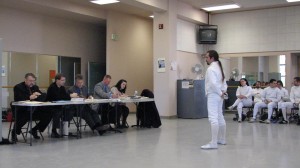
Fencing Master’s Examination
As such, I find myself in a strange position. My mundane self outranks my SCA persona.
I am a board certified Master at Arms entrusted with preserving an Italian martial art with a teacher-to-student lineage which dates back to the mid-1600s through the Scuola Magistrale Militare di Roma. I have taught fencing both within and without the SCA. In addition, I travel both inside and outside the United States to train and to teach European sword arts specializing in the historical Iberian traditions.

Dr. Mary Curtis
My wife and partner in these efforts is Dr. Mary Curtis. She is a Fulbright scholar and holds a PhD in Golden Age Spanish literature with a focus on the historical sword arts of the period. Dr. Curtis is also a White Scarf of the Kingdom of the West and she lived in Spain for a year combing through archives to research historical fencing.

Gabriela de Avila, Order of the White Scarf
It is with some reluctance that I admit I may be an SCA fencer of some note, but I also assert that were it not for the SCA I never would have achieved these things. In that sense, my accomplishments are a reflection of the Society itself and what is possible when a young man or woman is given a good start in the world.
Perhaps it seems obvious what events have led us to this crisis of leadership in the Society. You will be receiving a slew of angry letters. I am not interested in assigning blame but instead in finding solutions. I shall suggest a different cause for our troubles and in so doing perhaps bring some hope and light into the conversation.
The problem is fidelity.
It is fellowship.
It is our love for those who excel and do wondrous things.
There is a lack of equity in the awards structure but the love that people hold for each other remains the same. When a king or a queen sees a subject shine like a beacon their need to serve the subject stumbles because their hands are tied. This has put the SCA under increasing social pressure as it tries to balance an outstanding (but diminishing) prejudice against fencing with a desire to recognize people of value in a fair way. That pressure has erupted in different ways.
Consider two different solutions to the building social pressure:
- Ansteorra’s White Scarves are peers in all but name. Their order mirrors the Cult of Elizabeth and it is deeply embedded in the kingdom’s psyche. The relationship between their White Scarves and the queen is a cherished part of the national identity.
- Other kingdoms like An Tir have resolved the problem by making rapier Laurels. These Laurels have to meet a Laurel’s requirements for period fencing research and practice to join their order.
The board’s recently proposed solution was to steer the fencers into the Chivalry based primarily on fighting prowess. By stumbling out of the gate with a surprise decision the board has created a conflict between the Chivalry and the rapier community. That conflict has fanned old fiery tensions which had largely cooled into bonds of fellowship. Now, tempers are rising on both sides.
And what of our knights?
The Chivalry represents a pool of potential governance sworn into fealty. From the Chivalry typically arise the kings and queens of the Society. The responsibilities of rulership are not insignificant and are completely beyond the scope of the fencing community. I can see value in protecting a private space which allows the Chivalry to hash out difficult subjects and provide a unified presence. (I say this as an outsider having never participated in a chivalric circle.)
As a fencer, I should also confess that I never dreamed of the title of “Sir.” Nor did I imagine that someday I might take squires. These are not fencers’ dreams. A fencer’s dream is to be a Maestro d’Armi (Master at Arms). When the SCA could not help me realize this goal, I went out into the mundane world and did the work required to make that dream a reality.
Therein lies your solution. My understanding is that the order of the Master at Arms was created to solve a similar problem. The SCA had created some bright shining stars of martial prowess and grace on the rattan field. There was a social pressure to recognize these peers for what they were but, for religious reasons, these fighters could not swear oaths of fealty. These individuals had qualities so great that a solution was proposed and the Masters at Arms were created.
This peerage can again resolve the social pressure to recognize gifted people if we but accept that a Master at Arms can be skilled with a variety of weapons. Their order is a natural fit for martial arts beyond the scope of romantic chivalry. That might be rattan, fencing, mounted combat, archery, or thrown weapons. All of these things are obviously martial arts worthy of recognition and the Masters at Arms will be the least impacted peerage in the Society.
I urge you to preserve the Chivalry’s space in which they govern. Knights must swear their oaths and the burden they carry is unique. Respect that. Instead, open the peerage of the Masters at Arms to those who wield diverse arms and the problem is solved in a lasting and meaningful way. By creating a firewall between the Master at Arms and the Chivalry the unsworn peerage is allowed greater function without sacrificing historical correctness. If the Chivalry wish to retain the currently existing Masters at Arms in their circle they have only to extend an invitation. (Inviting others into their space for counsel is their privilege.)
What of the White Scarves then?

Estrella 2008 – Cut and Thrust
The original White Scarf iconography was inspired by a white sash worn as a baldric indicating military command. (Cyrano de Bergerac contains a notable example when he recovers De Guiche’s sash of command from the battlefield at great personal risk.) Since wearing a white scarf as a baldric conflicted with the white baldric worn by the Masters at Arms, White Scarves instead wore a scarf as a lady’s favor, and this emblem of rank has become the queen’s favor.
Imagine reuniting the White Scarf with its origin as the baldric of command in a peerage ceremony. I ask you to cast your eye forward to see this moment realized.
A member of the Order of the White Scarf is brought before the king and queen. At her arm is tied the white scarf indicating the queen’s favor but on this evening she wears two scarves; one long and one short.
“Will you become our master and teach your art to the people of this kingdom?”
“I will,” she replies.
In the torchlight the longer scarf is then tied crosswise across her body to form a master’s baldric and a Maestra d’Armi is created.
To open a school of fencing. To be a master. To serve the kingdom. These are the dreams of a fencer and now more than any time in our Society’s history this dream is possible.
I say this to you as a classical fencing master myself. I say it to you as a White Scarf of the Society. I say this to you as a person who understands the love and fidelity of our Society. Allow the Master at Arms to again be the solution which binds us closer together in love, fellowship, and fidelity.
In brief summary,
- We arrived at this place because of our fidelity.
- Create a firewall between the Order of the Chivalry and the Masters at Arms.
- Open the order of the Master at Arms to diverse arts.
- Assert that the Chivalry can invite a Master at Arms into council as they see fit.
With respect and gratitude for your service,
R. E. “Puck” Curtis III
Master at Arms, San Jose Fencing Master’s Program
Known in the Society as
Don Pachomius Oneshoe
Member of the Order of the White Scarf of Ansteorra
Filed as General with no replies
Are you angry that the Democrats were beaten in the midterms? If you are, the number you need to repeat every day is “3,600”. I will explain.
The recent elections are a generational struggle between the Silent or “Lucky Few” generation and the Millennial generation. It isn’t unusual to place the blame squarely at the feet of the massive Baby Boomer generation but that cohort has been reliably split between the two parties. The Boomers display a slight Democratic preference offset by a larger degree of racial intolerance than the younger generations. By contrast, the older Silent generation is staunchly Republican and much more racially intolerant than any other generational group still capable of forming a voting bloc. They are even more Republican than their predecessors, the Greatest generation.
“The demographics race we’re losing badly,” Sen. Lindsey Graham (R-SC) told the Washington Post. “We’re not generating enough angry white guys to stay in business for the long term.”
Boomers and Xers
The Boomers are so split that they largely negate themselves. When the Boomers agree they make a big difference but they often don’t. The Gen-Xers skew slightly in favor of the Democrats but not enough to outweigh the conservative half of the Boomer cohort married to the monolithic conservatism of the Silents.
The Young Challengers

Millennials are the largest generation numbering at 95 million compared to 78 million for the Baby Boomers.
The Millennials are the largest generation in history, the most racially diverse and tolerant, and also the most liberal. They have been very unlucky economically and are taking repeated punches as they try to establish themselves in the world. They have enormous student loans, no acquired capital, delay marriage, delay children, and cannot afford a house. The youngest Millennials are about 14 years old in 2014 and by 2018 they will all be eligible to vote.
The Reigning Champions
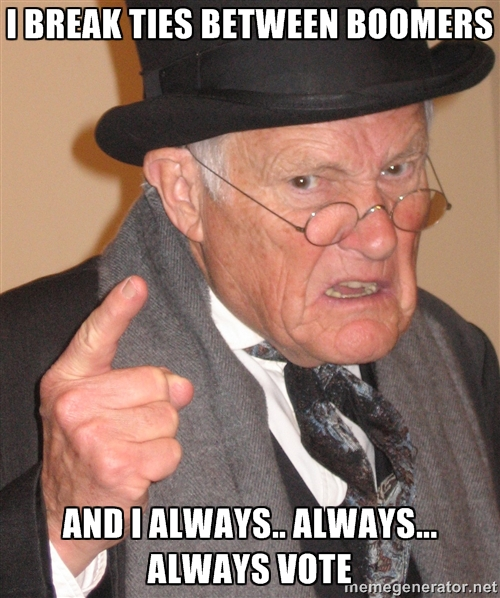
The Silent Generation are the swing voters that pull the Boomers one direction or another.
On the other side, the Silent generation has earned the moniker “The Lucky Few”. They have enjoyed a series of wonderful advantages in their lifetimes which ensured they were largely debt free, owned a home, and could comfortably retire. As a cohort it makes some sense that this generation feels like you should be able to work your way out of poverty because their unique economic environment made this almost universally possible. The Silents range in age from about 70 years old to about 86 with a median age of about 80.
This lays out an interesting struggle between the very liberal Millennials and the very conservative Silent generation. What it also tells us is that the struggle between Silents and Millennials has an expiration date measured by the life expectancy of the Silents. Using birth rates and mortality tables we can begin to lay out the pattern that will guide the next major shift in American politics.
I did some math…
I created a model of the US population consisting of approximately 300,000,000 people. I divided that group up into birth-year groups and applied percentages from the following source using 2012 data to find the size of the population for each year:
To these single-year groups I then used demographic information from the 2012 presidential election to assign age-based voting patterns.
Once I had the groups, I applied 2009 CDC mortality statistics to each year-group to find projected numbers for new voters and the deceased voters. (By using only male mortality numbers, I skew the results towards the GOP by assuming women die at the same rate. This is untrue but it provides the GOP a bit of an edge in the final calculation.)
What did I find?
Using the 2012 presidential election results combined with the CDC data we can predict which voters will be born and which will die.
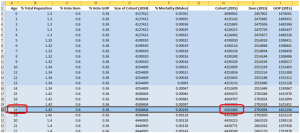
Click for Details
4,503,489 New Voters / 365 days = 12,338 new voters per day
On any given day about 12,000 young people turn 18 years of age and are eligible to vote. (By rounding down to 12,000, I skew the results towards the GOP. In reality, the number of new voters will likely be higher.)
New Voters Turning 18:
- D – The Millennials will add about 7,200 Democratic voters per day. (60%)
- R – The Millennials will add about 4,300 Republican voters per day. (36%)
On the other side of the equation when considering only the population over 65 about 6,000 people die every day.

Click for Details
The circled value of 2,308,289 deaths is calculated by applying the yearly mortality rate provided from the CDC to project a smaller group of 2015 survivors. By subtracting column H from column E we attain the number of deceased votes in the 65 or older group.
2,308,289 deaths / 365 days = 6,324 deaths per day
By rounding this number down to 6,000 deaths per day in the over 65 group we again provide conservative voters a slight advantage in the final calculation. The actual number of deaths each day will probably be higher.
Deaths:
- D – This results in 2,600 Democratic voters removed from the voting population per day. (44%)
- R – This results in 3,300 Republican voters removed from the voting population per day. (56%)
Net Gains:
New – Removed = Net Gain
D: 7,200 – 2,600 = 4,600
R: 4,300 – 3,300 = 1,000
- D – 4,600 added Democrats per day (net gain)
- R – 1,000 added Republicans per day (net gain)
Democrats are out-pacing Republican growth by a margin of almost 5-to-1.
Each and every day the Democrats gain a net advantage of 3,600 voters. It will take some time for the trend to become dominant but it amounts to 1,314,000 new net Democratic votes each year. Presidential elections will likely be dominated by the growing power of the Millennial vote but midterms will still skew older. That will result in a pendular effect from election to election. By the time the youngest of the Silent voters reach 77 in 2020, well over half of the Silent generation will be deceased. By 2024 about 66% of the youngest Silents will be deceased.
If we held these trends artificially steady from 2015 until 2020 we would see:

Voter Gains by Year
Final Thoughts
- The country is creating new Democratic voters much faster than new Republican ones. (Almost 2-to-1.)
- The concentration of Republicans in the Silent Generation mean the GOP loses voters much faster than Democrats. (About 2-to-3.)
- The rate of increase in Democratic voters is almost 5-to-1.
- In 2012 Obama won the popular election by less than 5,000,000 votes.
- In 3 years the Millennials will add over 5,000,000 new Democratic leaning voters to the population.
- In 4 years the Millennials will create a more than 5,000,000 vote advantage over the GOP.
The finding is that the Republican party is being eaten away from both sides by the demographic changes. My estimations are actually a best case for the GOP and these trends should accelerate rather than progress linearly as I show above.
As an example, if the average age of a Fox News viewer is 68, about half of those viewers will pass away in the next 14 years and their likelihood of dying increases each year along an exponential curve. Other considerations are that red states typically have life expectancies 1-3 years lower than blue states and men are more likely to be conservative than women but have life expectancies 2-3 years shorter.
At a glance the 2016 presidential election should draw wide turnout across all generations and it seems like the Democrat’s election to lose. The more interesting election may be the 2018 midterm because it provides us a metric to measure the decline of the Silent generation’s voting bloc just as the Millennials begin to realize their generation’s political power.
Consider the difference in the behavior of the Senate when one party holds a super-majority over the other. As an analogy that has been the racial reality in the United States for its entire history thus far. The racially white super-majority population in the United States is vanishing and it will also change how America governs. Whites will no longer be able to dictate governance to a nearly powerless collection of minorities. This terrifies many older Americans but for the Millennials this is already their demographic experience.
To paraphrase Fox’s Megyn Kelly, this number-crunching is clearly math that liberals will do to make themselves feel better after a bad midterm. Even so, the math appears to be sound. That new liberal power-house is measurable at 3,600 more liberal votes per day and growing.
More details about the gaps between the current generations can be found here:
Filed as Classical Fencing, Destreza (Spanish swordplay), Fencing, General, Historical Fencing with no replies
In July 2014 the Sacramento Sword School held its second student examination. The exam consisted solely of Scholar candidates, it was open to the public, and it was judged by a board of fencing masters with Dr. Mary Curtis acting as a special advisor to the board. In addition, this was the first time the Scholar’s examination was offered to a candidate from an external school and our we extend our fellowship and congratulations to the Elite Fencing Club in Mexico City for their candidate’s attendance and excellent performance.
To provide some context the Sacramento Sword School Scholar’s test is a La Verdadera Destreza examination derived from both the classical fencing examinations and material outlined in Don Luis Pacheco de Narvaez’s “Easy Method for examining Masters…” published in 1625. At the Scholar level the test is intended to qualify that a student has competence reflecting six months to one year of training and study. The process includes preparing and receiving feedback on a example lesson, an oral examination, the candidate receiving a lesson, and the candidate teaching a lesson. In addition, the board may ask to observe free fencing or for the candidate to teach specific fencing actions if time permits.
The Board of Examiners:
- Kevin Murakoshi (Master at Arms)
- Eric Myers (Master at Arms)
- R. E. “Puck” Curtis III (Master at Arms)
- Mary Dill Curtis (PhD – Golden Age Spanish Literature acting as an advisor)
Scholar candidates in alphabetical order:
- Evans, John
- Kalleen, John IV
- Pacheco Ancheyta, Jorge Luis
- Smith, Eric
- Smith, Olivia
- Welsch, Michael
- Minor (name withheld)
Each of these candidates passed the examination in good order with some performance occasionally reaching beyond Scholar level towards Freescholar level. The Sacramento Sword School is pleased to extend our endorsement of each of these candidates based on their performance during the examination.
A complete list of Scholars examined by the Sacramento Sword School alphabetically by year:
- Murphy, Dan (2013)
- Wright, Tyson (2013)
- Evans, John (2014)
- Kalleen, John IV (2014)
- Pacheco Ancheyta, Jorge Luis (2014)
- Smith, Eric (2014)
- Smith, Olivia (2014)
- Welsch, Michael (2014)
- Minor (name withheld) (2014)
-

-
Mr. Evans
-
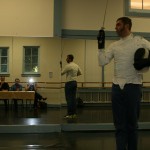
-
Mr. Kalleen
-

-
Mr. Pacheco Ancheyta examines the guard of Mr. Smith
-
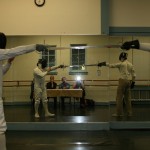
-
Angulo Recto
-
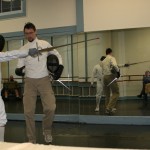
-
Mr. Smith examines the guard of Mr. Pacheco Ancheyta
-

-
Atajo
-

-
Atajo, transversal, and thrust
-
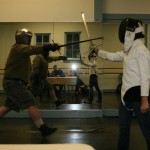
-
Mr. Wright and Ms. Smith
-

-
Mr. Wright and Ms. Smith
-

-
Mr. Smith and the Board
-

-
Mr. Pacheco Ancheyta and the Board
-

-
Group Photo

























